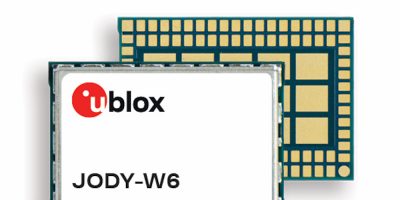Texas Instruments has introduced new semiconductors designed to improve automotive safety and intelligence. The AWR2544 77GHz millimeter-wave radar sensor chip is the industry’s first for satellite radar architectures, enabling higher levels of autonomy by improving sensor fusion and decision-making in ADAS. TI’s new software-programmable driver chips, the DRV3946-Q1 integrated contactor driver and DRV3901-Q1 integrated squib driver for pyro fuses, offer built-in diagnostics and support functional safety for battery management and powertrain systems. TI is demonstrating these new products at the 2024 Consumer Electronics Show (CES).
Many automakers are adding more sensors around the car to improve vehicle safety and autonomy. TI’s AWR2544 single-chip radar sensor is the industry’s first designed for satellite architectures. In satellite architectures, radar sensors output semi-processed data to a central processor for ADAS decision-making using sensor fusion algorithms, taking advantage of the 360-degree sensor coverage to achieve higher levels of vehicle safety.
The AWR2544 single-chip radar sensor is also the industry’s first with launch-on-package (LOP) technology. LOP technology helps reduce the size of the sensor by as much as 30% by mounting a 3D waveguide antenna on the opposite side of the printed circuit board. LOP technology also enables sensor ranges to extend beyond 200m with a single chip. In satellite architectures, these features enable automakers to increase ADAS intelligence for higher vehicle autonomy levels to make smarter decisions from farther away. The AWR2544 is the latest in TI’s radar sensor portfolio, which supports a wide range of ADAS applications and architectures with sensors developed for corner, front, imaging, side and rear radar systems.
Supporting the trend toward software-defined vehicles is challenging designers to develop smarter, more advanced battery management systems (BMS). Two new highly integrated, software-programmable driver chips from TI address requirements for safer and more efficient control of high-voltage disconnect circuits in a BMS or other powertrain system. Both drivers are International Organization for Standardization (ISO) 26262 functional safety-compliant and offer built-in diagnostics and protection to reduce automotive engineers’ development time.
For BMS and other powertrain systems, the DRV3946-Q1 is the industry’s first fully integrated contactor driver. It includes a peak-and-hold current controller that helps automakers increase system power efficiency. The device also implements safety diagnostics to monitor the condition of the contactor.
TI’s DRV3901-Q1 fully integrated squib driver enables an intelligent pyro fuse disconnect system by using built-in circuitry to monitor the pyro fuse and provide diagnostic information to the system microcontroller. This gives hybrid electric vehicle (HEV) and EV BMS designers flexibility to use a pyro fuse instead of traditional melting fuse systems while minimizing design complexity.







